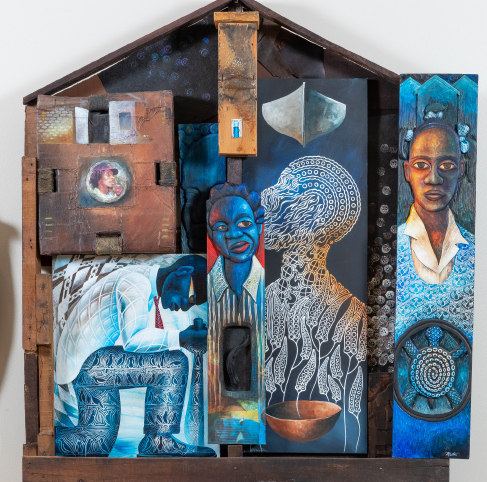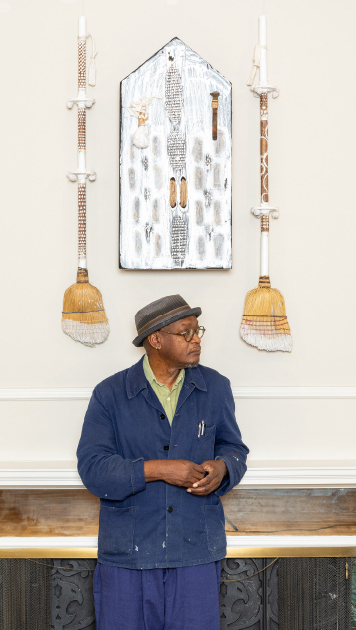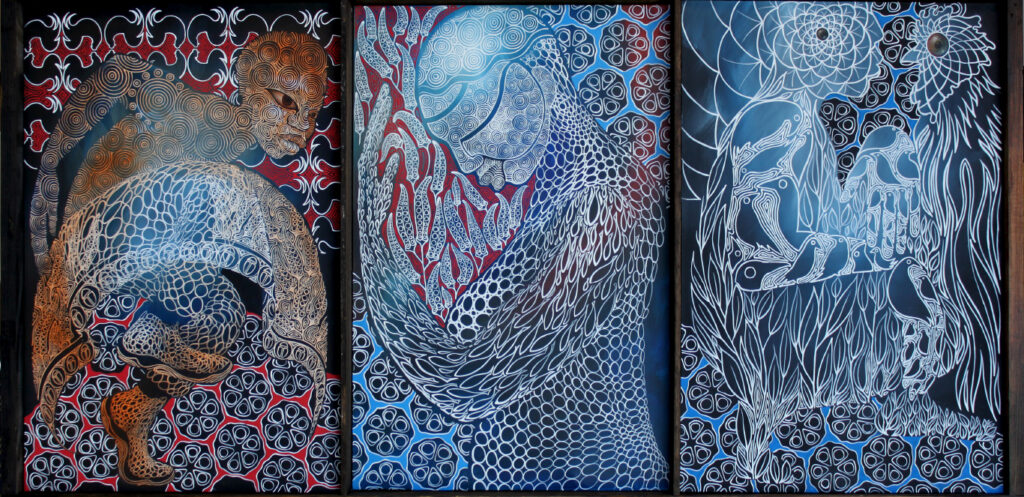
A Quantum Exchange:
The Art of Daniel Minter in
Diasporic Context
Daniel Minter’s art is a navigation system. A map to another tone in the world. In the midst of an historical moment in African American life that some compare to Rayford Logan’s post-Reconstruction “nadir,” Minter’s work offers both assessment and arsenal. He describes his art as a technology; a mode of creativity that uses African diasporic sensibilities to enable an alternative understanding about the world; a way to recognize and access ancestral resources for individual and collective struggle. The artist’s creative production includes sculpture, painting, illustration, printmaking and assemblage/installation, all rooted in a necessary usefulness and nurturing. “My idea of the purpose of art” Minter says, “is to give people ways of using culture to solve everyday life problems.”
This emphasis on the utilitarian in his art is reflected in the metaphoric range of Minter’s symbols. Growing up in the small farming community of Ellaville, Georgia in the 1960s and 1970s, his vision and work emerged from the soil, sites, implements and histories of Black southern life. Minter’s art is heavy with gross materiality – thick planks of wood, found objects, metal, wire, stone, the heft of human presence in the world; and particularly, the physical and psychic weight of Black embodiment in the Americas, especially in the US Blackbelt South. And at the same time, there is an astonishing ephemerality in the work. Sometimes, as in the assemblage, “A Distant Holla,” these two tendencies exist side by side, interwoven and conversing, in continuum.
Although he spent his formative years in Georgia, Minter has lived elsewhere for more than two decades – first in the Pacific Northwest, then in Chicago and New York, now in Portland, Maine. He travels widely – and has spent periods in Brazil, East Africa, Mexico and the Caribbean. He favors working in community with other visual artists and his artwork has a decidedly diasporic cast.
In some important ways, Minter’s mode aligns with that of other Black creatives – scholars, writers, musicians, dancers and visual artists – whose approach, sometimes considered afropessimist, acknowledges and explores the depth and breadth of the inherent antiblackness at the heart of modernity; its historicity; and the fact that it is not likely to disappear from the earth anytime soon. In a conversation with Minter earlier this year, he talked with me about the commodification of Black bodies and Black productivity at the founding of the modern world – and how slavery, and the persistence of Black fungibility has provided the reigning paradigm for capitalism into the 21st century; using up everything and everybody until there is nothing left. And then using the carcass.
What we see in Minter’s work is the profound recognition of the assault on, and the precarity of, Black life; melded to an equally essential emphasis on “another tone.” In fact, his greater accentuation is on the alternate timbres, which are also conceptual tools; those vital, transformative modes of being, that are cultivated over generations and that carry an-other meaning of the possible (an afrofuturist vision) at their heart. Minter’s art is the labor of tender excavation, unearthing the wisdom buried in the culture – sometimes deep in the terrain of memory, sometimes flat-footed in plain sight all around us. Minter’s vision helps us recognize and reinterpret the strengths and possibilities in a radically inclusive African American and Afro-diasporic vision of the world.
Diaspora Literacy
The late cultural critic and performance scholar, Vèvè Clark, developed a concept she called “diaspora literacy,” to describe the capacity to “read” texts from Indigenous and African diasporic cultural perspectives “beyond the field of Western or westernized signification.”[1] Reading Daniel Minter’s work, at its deepest levels, requires a certain fluency of the sort to which Clark referred. So much of his art is steeped in the tropes and meanings of Southern African American culture that viewers without at least some familiarity with Black histories, idioms and traditions may miss some of the deeper-strata information he shares with us. But Minter’s work is also a strategy and a pedagogy – instructing viewers in the essential elements of its language and suggesting ways to engage its multiple meanings.
Over the course of his career, Minter has both searched out and created an iconography of Afro-Atlantic experience – a set of symbols that are powerfully centered in the Black US historical context but that are also visual cousins to symbols from the Caribbean, West and Central Africa, and especially, Brazil. Inspired by the koan-like short poems of Lucille Clifton, (especially those in her series, Blessing the Boats[2]), Minter was drawn to the idea that a simple image or figure can tell a complex and layered story and that there are certain recurring, elemental and iconic symbols in Afro-Atlantic life that could be gathered as a kind of codex of Black experience in the world. With Clifton’s poetry as a catalyst, Minter began to systematically observe and note similarities among the symbolic resources of diasporic communities and more consciously include these in his own artwork. His visual language includes reiterations of water and wind; fish and boats; musical instruments; brooms, axes and other implements of labor; bottles and bowls; Black people’s faces, bodies and hair; traditional foods like okra, black-eyed peas and greens; turtles; birds; and various representations of Spirit, the continuity of the lifeforce, and the power of healing in the world.
Minter calls these symbols, “keys.” And he is especially drawn to the way the symbols contain and transmit stories, lessons, wisdoms. He began exploring the “keys” as block print carvings – wanting to make sure he used images that people could recognize and feel connected to, with the intent of building a visual and conceptual grammar that would resonate as broadly as possible across African American and African diasporic experience.
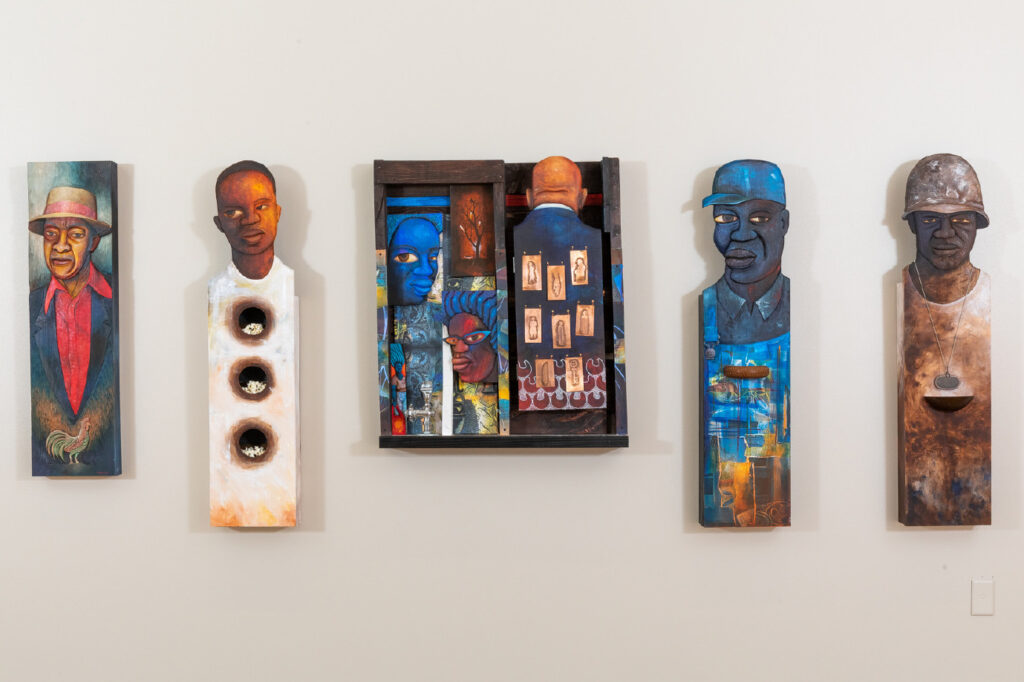
In many of his paintings and illustrations, Minter employs a technique of lace-like tracings, white lines superimposed on human figures or appearing within the shapes of items on his canvases. The lines are generally decorative, enhancing the forms in the paintings – often they function as a flourish in clothing, or as a recurring pattern – subtle or bold – in the background of the work. The tracings frequently mark a space in the art where fundamental symbols of Minter’s oeuvre repeat themselves and, taken as a whole, begin to give us a sense of the “alternative routes” Minter sees abounding, as an ancestral indigenous inheritance, just below the surface (or, above it, like a spiritual stanchions) of the regular, mundane world.
This symbology, for Minter, are part of the iconography of resilience and resistance;
of healing and renewal that, in both conscious and subconscious ways, have been elements of the survival of African American people and of the indigenous ways of being in the world that persist among the descendants of those who were enslaved in the Americas. Daniel explains, “I want Black people to know that we carry these resources, our cultural resources with us all the time, not just when we are in ceremony or ritual or worship. We have access to them all the time – at our jobs and when we’re going about our daily lives.”
The Indigo Arts Alliance: Diasporic
Collaborations
Whether in the bricks and mortar of an influential cultural arts institution
(Indigo Arts Alliance) or in the symbolic vocabulary of his paintings, Daniel Minter’s labor is a reminder of the resources we carry with us – the cultural strengths and spiritual insights that are as if another set of internal veins or an exoskeletal possibility. For the artist, the materiality of the culture holds knowledge and historical experience as well as futurity. It also holds an indigenous, ancestral orientation that posits blackness as humanness and humanness as imprinted with (and in relationship to) all other forms of life in the universe. His artwork guides, like the unborn child narrator of Julie Dash’s Daughters of the Dust, asserting: “I remember and I recall.”
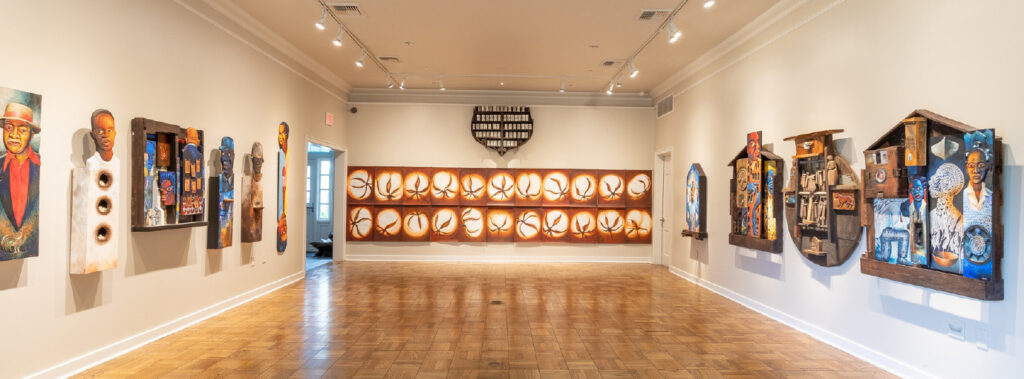
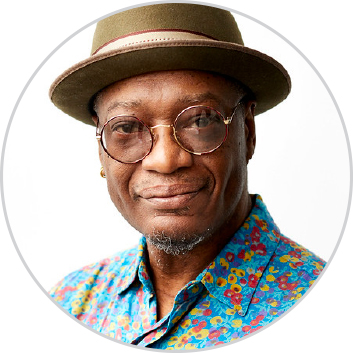
DANIEL MINTER
Daniel Minter is an American artist known for his work in the mediums of painting and assemblage. His overall body of work often deals with themes of displacement and diaspora. Minter’s work has been featured and acquired in permanent collection by numerous institutions and galleries including the Portland Museum of Art, Seattle Art Museum, The Charles H. Wright Museum, Tacoma Art Museum, Bates College, University of Southern Maine, Center for Maine Contemporary Art, Bowdoin College Art Museum, Farnsworth Art Museum, Bates College Museum of Art, The David C. Driskell Center and the Northwest African American Art Museum. In 2021 Minter was awarded the prestigious Joyce Award. In that same year he was awarded the distinguished Caldecott Medal. Minter has traveled extensively across the African Diaspora. A travel grant from the National Endowment for the Arts enabled him to live and work in Salvador, Bahia Brazil where he established relationships that have continued to nurture his life and work in important ways. Minter has illustrated over fifteen children’s books, many of them award winning, including the Coretta Scott King Illustration Honor. He was also commissioned in both 2004 and 2011 to create Kwanzaa stamps for the U.S. Postal Service. As founding director of Maine Freedom Trails, he has helped highlight the history of the Underground Railroad and the abolitionist movement in New England. For the past 15 years Minter has raised awareness of the forced removal in 1912 of an interracial community on Maine’s Malaga Island. His formative work on the subject of Malaga emerges from Minter’s active engagement with the island, its descendants, archeologists, anthropologists and scholars. This dedication to righting history was pivotal in having the island designated a public preserve. In 2018, Minter co-founded Indigo Arts Alliance, a non-profit dedicated to cultivating the artistic development of people of African descent. Minter is a graduate of the Art Institute of Atlanta and holds an Honorary Doctorate of Arts from The Maine College of Art.
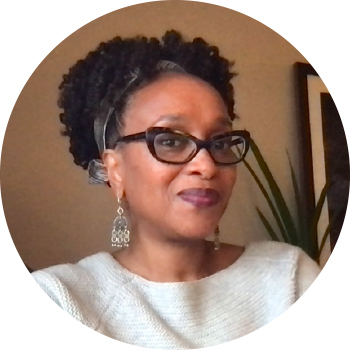
DR. RACHEL ELIZABETH HARDING
Rachel Elizabeth Harding is a poet and historian. A native of Atlanta,
Georgia, Dr. Harding teaches in the Ethnic Studies department of the
University of Colorado Denver and writes about religion, creativity and
social justice organizing in the experience of people of African descent
in the Americas. She is author of two books: A Refuge in Thunder,
a history of the Afro-Brazilian religion, Candomblé; and Remnants:
A Memoir of Spirit, Activism and Mothering, co-written with her late
mother, Rosemarie Freeney Harding, on the role of compassion and
mysticism in African American activism.
Dr. Harding is an egbômi (ritual elder) in the Terreiro do Cobre
Candomblé community in Salvador, Bahia, Brazil where she has been a
member for over twenty years. Harding’s honors include a Cave Canem
Fellowship, the Sterling Brown Distinguished Visiting Professorship at
Williams College and an honorary doctorate from the Starr-King School
for the Ministry.
“Daniel Minter is an artist whose work inspires visually and intellectually, for his formal mastery of several genres is wide as well as deep, and he knows the history and art history of the peoples of the African diaspora. This means that the term multidisciplinary applies to Minter’s art, but multidisciplinary only begins to capture his process. In formal terms, Minter works in several mediums—painting, carving, printmaking, and collage, sometimes in combination in the same work. His paintings have sculptural depth, and his palette tends to be somber, creating visual emphasis through the use of sharp contrasts. His works’ drama stems also from the power of figures expressed iconographically, so they strike the viewer as symbolic as well as historically narrative. Given the richness of his oeuvre and the breadth of his reach, it’s not surprising that he has been honored for his work in illustration (children’s books, postage stamps) as well as in fine art.”
—Nell Irving Painter, Professor of American History at Princeton University
